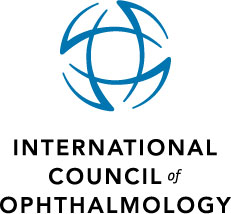Patient: 50 years of age, female, BCVA 0.16, IOP 22 mmHg, axial length 21,8 mm.
Ocular Medical History: intermittend increased IOP (30-40 mmHg), optic nerve atrophy, 3 weeks ago cataract surgery with cyclophoto coagulation, now pupillary block with IOP of 60 mmHg.
General Medical History: Mucopolysaccharidosis Typ I Pfaundler-Hurler, hydrocephalus interna.
Main Complaint: Increased IOP and decreased vision.
Findings:
(1) Slit-lamp photograph of the right eye before laser iridotomy shows total synechiae and anterior bowing of the iris.
(2) SL-OCT images show typical iris bombé with extensive peripheral iridocorneal contact.
(3) SL-OCT of the right eye after laser iridotomy shows deepened anterior chamber.
Discussion:
Iris bombé is an uncommon severe complication of uveitis. SL-OCT showed the anatomic structures of the anterior segment, including iris thickness, anterior chamber depth and the extent of anterior iris bowing before and after iridotomy.
The mucopolysaccharidoses (MPS) are a group of disorders characterised by accumulation of glycosaminoglycans (GAG) within a wide variety of tissues, including those of the eye. The MPS have been subdivided into different types depending on clinical manifestations. They encompass a wide spectrum of phenotypes, ranging from those disorders, which are fatal in the first months of life to those compatible with a normal lifespan. The MPS result from inherited abnormalities of specific lysosomal enzymes involved in degradation of GAG. Mucopolysaccharidoses type I (MPS I) is caused by abnormalities of the enzyme a -L-iduronidase. Ocular hypertension and glaucoma occur in MPS due to GAG acumulation within anterior chamber structures. This can lead to narrowing of the anterior chamber angle, and deposition within trabecular cells may lead to obstruction of outflow. MPS IH Hurler syndrome presents with facial dysmorphism and respiratory disease in early life, and patients may be referred to the ophthalmologist once the diagnosis is already made for detection of associated corneal opacification. The prevalence of ocular complications in patients with MPS was retrospectively reported by Ashworth JL et al.(1). They found in MPS IH patients: in 79% visual acuity of less than 6/12 equivalent in their better eye, in 16% severe corneal opacification, in 16% optic atrophy, in 1% ocular hypertension.
Literature:
(1) Ashworth JL, Biswas S, Wraith E, Lloyd IC. The ocular features of the mucopolysaccharidoses. Eye (Lond). 2006 May;20(5):553-63
-------------------------- --------------------------
-------------------------- --------------------------
-------------------------- --------------------------
-------------------------- --------------------------
-------------------------- --------------------------
-------------------------- --------------------------





